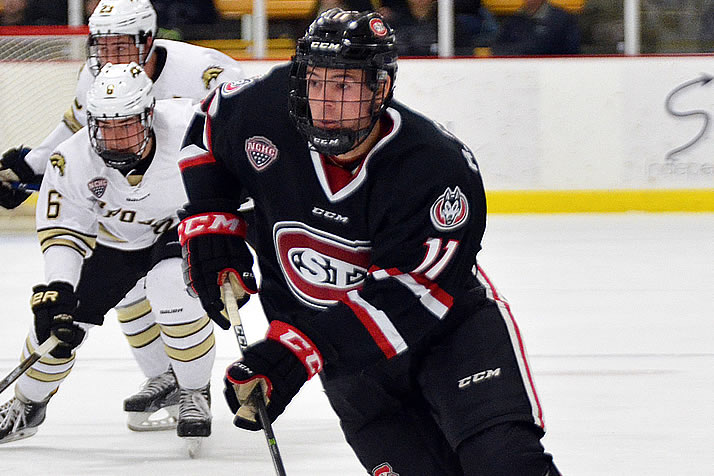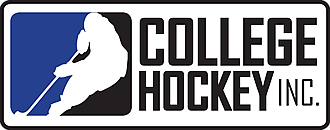Monday, June 19, 2017
Drafting from NCAA Produces Success
Players in 2006-13 drafts who spent their draft year in college outperforming others.

When St. Cloud State freshman Ryan Poehling decided to accelerate his high school classes and join the Huskies as a 17-year-old, he did so to challenge himself on the ice and to play with his older twin brothers, Jack and Nick.
History also suggests that he may have improved his chances of making an impact in the NHL.
2017 NCAA / NHL Draft Guide (.pdf) | NCAA Players, Recruits in Draft Rankings
A small subset of the selections in the 2017 NHL Draft this Friday and Saturday spent this past season playing NCAA hockey, like Poehling.
A study of eight drafts from 2006-13 shows that those players – likely around a dozen – could be the best values in the draft.
Those eight drafts featured 73 players who played college hockey in their draft season. Of those, a remarkable 66% have reached the NHL for at least one game and 32% have appeared in more than 100 NHL games. Those figures are 23 and 13 percentage points higher, respectively, than all other players in the draft.
Players drafted out of the NCAA have not just reached the NHL, but made a significant impact. Players in this study include first-round picks Phil Kessel and Colin Wilson, who just met in the Stanley Cup Final, as well as later-round success stories like goaltender Chad Johnson and defenseman Justin Braun.
Older Competition
Most NHL draftees are 18 years old and the average age of an NCAA freshman is older than 19, so there are relatively few draft-eligible player in the NCAA each year.
Those who are playing college, however, get to compete against older players – often as old as 24 or 25. That gives scouts a chance to evaluate prospects against opposing players who are closer, physically, to what those prospects would face in the NHL.
In the 2015 NHL Draft, three current college players were taken in the first eight selections (Jack Eichel, Noah Hanifin, Zach Werenski). TSN Director of Scouting Craig Button said at the time that it helped scouts to see those players compete at the college level.
“One of the biggest things watching players at 17 or 18 is that you are trying to project what they will be like as an NHL player,” said Button. “You don’t get to see them play at that level – no sport does. But for Eichel, Hanifin and Werenski, you get to measure these players against bigger and stronger players who are closer to the NHL game. In my view there’s nothing but positives in that regard.”
Poehling, likewise, told NHL Network that he benefitted from the competition he experienced this year at St. Cloud State.
“I think I’ve adjusted well,” he said. “College hockey compared to what I had been playing is bigger, faster, stronger guys. I think this year of development for me will be big for the following year.”
Beyond the First Round
Success in the NHL Draft is vastly more unpredictable beyond the first round. While 92% of all first-rounders will reach the NHL, only 34% of players taken after the first round can say the same.
While players like Eichel and Werenski in 2015 and Charlie McAvoy and Luke Kunin last year get a lot of attention, most current NCAA players in the draft are taken after the first round. That may be where the biggest values lie.
Shayne Gostisbehere, Paul Stastny and Alec Martinez were all taken after the first round. Candidates to follow in their footsteps this year include Luke Martin (Michigan), Patrick Khodorenko (Michigan State) and Johnathan Kovacevic (Merrimack).
Second Chances
Many of the NCAA players taken in the draft are a year – or even two – older than the majority of players selected. That may account for some of their success relative to other draftees. While NHL teams tend to favor taking players in their first year of draft eligibility, a second-year eligible player may show something at the college level that wasn’t clear in junior hockey.
Such was the case for Gostisbehere, whose slight frame when he was headed to Union had teams wondering if his offensive gifts would shine through against NCAA competition. After they did, the Philadelphia Flyers grabbed him in the third round.
“Shayne had grown,” recalled Flyers scout John Riley, a former assistant coach at Princeton. “He still probably was a buck-fifty, but he was now 5-10 or 5-10 ½ and his intelligence with the puck was [working] at the college level.”
Current college players like St. Cloud State’s Jack Ahcan or Arizona State’s Brinson Pasichnuk could fit a similar profile in the 2017- NHL Draft. Both were eligible but not selected in 2016, then shined as freshmen and played big roles for their teams.
Ahcan recently turned 20 and Pasichnuk will in November. Though older than other draft prospects, that may give scouts a clearer picture of the player they will eventually become.
“Those years are such big development years, one year can make a huge difference,” said ISS Hockey Director of Scouting Dennis MacInnis. “I’ve seen a guy one fall who has been 5-foot-11 and by the next year he’s shot up to 6-2 and is a whole different player.”
NHL scouts never stop watching for the next impact player. Now more than ever, they are finding them in the college ranks.
Note: This study was initially published in June 2016 and has been updated to reflect the progress of those draft picks in the past year.
